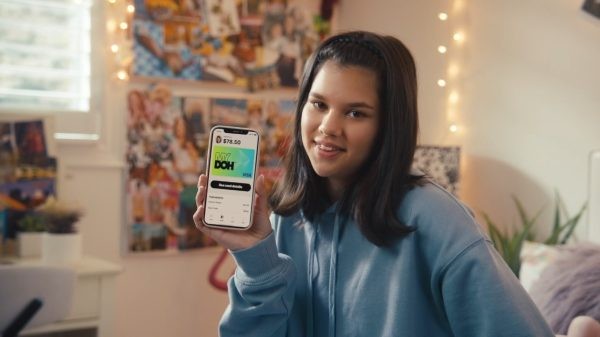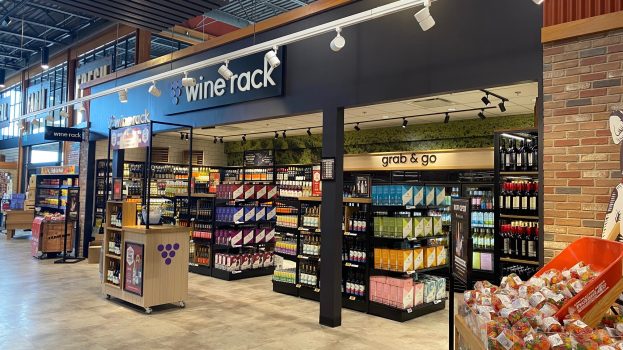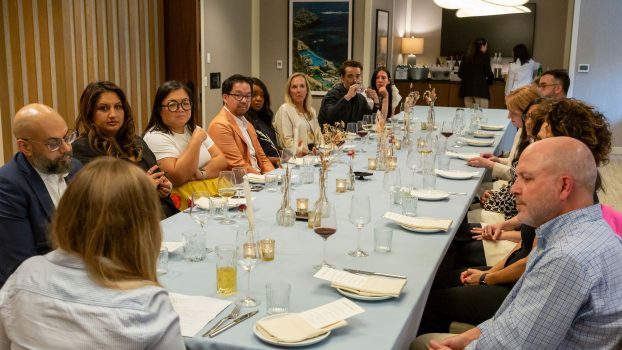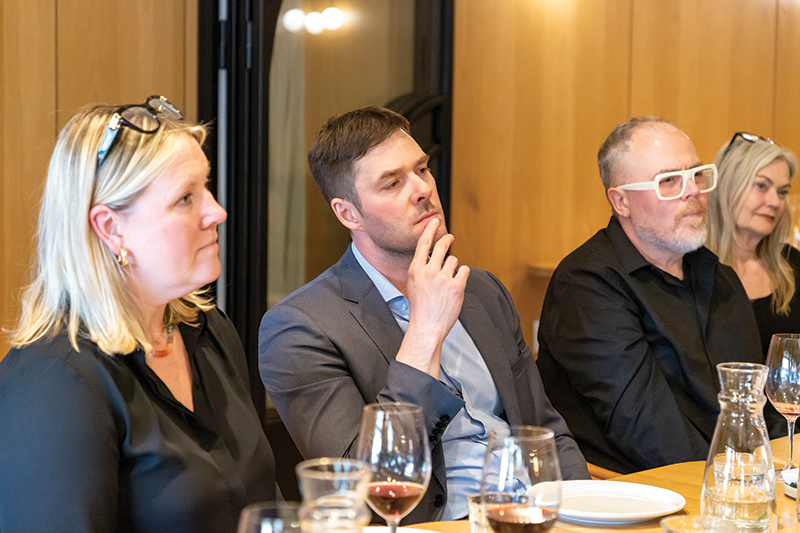
This story first appeared in the Summer 2025 issue of Strategy Magazine.
B2B marketing has traditionally been a behind-the-scenes effort, focused on direct sales and relationship building. But more brands are advertising around cultural moments, like the Super Bowl. And Cannes Lions debuted a B2B category last year, further signaling an evolution. The creative is also less homogenous. Instead of sticking to a sales approach centred on product specs and pricing decks, many have embraced consumer-style campaigns.
To understand the changing nature of B2B, we sat down with Nisha Carcasole, VP, consumer marketing, sponsorships, Mastercard; Audrey Davidson, head of integrated marketing Americas, Microsoft; Scott Lanaway, managing partner, Titan One; Ian Martins, EVP, managing director, Zenith; Devon MacDonald, president, CEO, Cairns Oneil; Tristan Retelsdorf, lead director, brand, digital, customer marketing at Telus, and Daniel Shearer, CMO, Maple. Here is what they had to share.
Jennifer Horn, editor and content director for strategy and Media in Canada, moderated the discussion. Also in attendance were strategy/realscreen EVP Mary Maddever, strategy and Media in Canada publisher Lisa Faktor, associate publisher Neil Ewen, Media in Canada reporter Andrea Hernandez, Globe Media Group managing director of ad products and innovation Tracy Day and group client director Shaenie Colterjohn.
What do you believe is driving the appetite for more creative brand-building in B2B?
Tristan Retelsdorf: I’m on Instagram just as much as any other consumer. So this idea that the only way you can reach a B2B buyer is through an official trade publication or a newsletter is actually false. Everyone is on Meta. Everyone’s Googling. Everyone acts like a consumer. And I think that overlap between how consumers and B2B buyers buy is much closer than you think.
We’ve seen a lot of success in embracing mass marketing in order to build our own brand awareness. It changes a bit as the conversation goes down the funnel, and you start talking about pricing, spec sheets and pitch decks. Then it starts to feel a little bit more B2B. But at the top of the funnel, you’re just trying to build brand awareness, good creative, or an idea that stands out and is going to help you six months from now when the buy occurs.
Audrey Davidson: In traditional sales for B2B, it’s always been based on relationships. Emotions will open the door and logic will close the deal. So creating an emotional connection is really important for us to be able to build on trust, which builds confidence, and takes us further.
Ian Martins: What differentiates businesses from a technological capability standpoint has eroded, because it’s easier to copy the feature sets from one business to another. There’s a need to create an emotional connection beyond the particular features of products and services. I think you see a lot of that pressure in SaaS businesses right now, where AI is heading. Someone can now replicate your SaaS business, even internally in some cases. So having a brand and that emotional connection is going to be really important as we go forward.
Daniel Shearer: The question for me is, why don’t most agencies want to work on B2B? It’s very category dependent, but it’s where the revenue is. Why aren’t big strategic and creative brains – in the agency context – wanting to work on these big stock-price-moving problems? That’s something I’ve been thinking about as I’ve stepped into my role at Maple, and how it’s not B2C or B2B, it’s B2H: business-to-human. We all know that people engage emotionally, and that you close the deal functionally or rationally. And I’m noticing a willingness to dive more into that now than in my 20 or 25 years in the industry.
Davidson: And I’d like to add to that it’s also become a lot more orchestrated, because it’s not just one buyer. You’ve got a buying group. And so it’s the whole influence sphere that matters. For example, let’s say you have five leads, but they’re all architects. I don’t need that. I need one from every function at a company to actually make the sale. So we need to think broader and more orchestrated in how we’re approaching it. And digital allows us to speed up and be more agile than we could in the past.
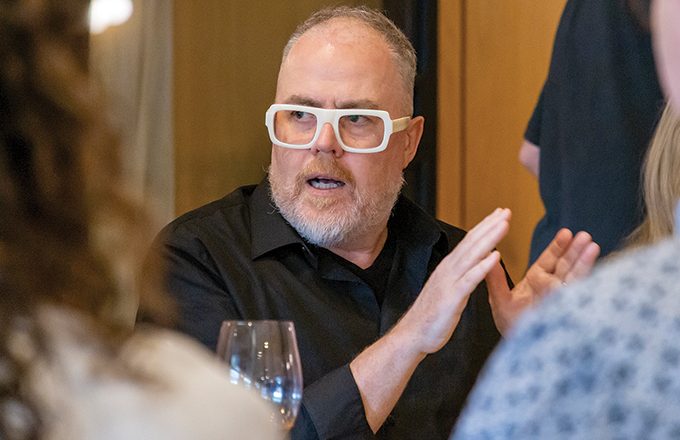
Scott Lanaway: This is where we’re starting to find opportunity, where you’re targeting people in different roles at different companies and influencing them at different stages, in different ways. We’re actually starting to see value in how we’re influencing target accounts, understanding that these buying decisions are complex. It’s disingenuous to think that one e-book with amazing content talking about how you can master digital transformation is going to win over the CIO. We’re craving more risk taking and creativity from our clients. And the marketing teams also want it. The CMOs are having a hard time selling it at the top.
Martins: New entrants and established brands take a very different approach to B2B marketing. If you’re a startup trying to take on large incumbents, you’re going to have different tools and tactics. So to make things even more complex, it depends on what kind of business you are, and what kind of businesses you’re talking to.
Nisha Carcasole: A large part of B2B marketing is the employees within an organization. Are the employees knowledgeable about the products and not just the key selling features? What are the differentiators? What is the solution that you’re looking for in this product? You can throw millions of dollars at a campaign, but when they try to talk to somebody within the organization, if they aren’t able to articulate the same emotions that you’re trying to evoke, then you’re not going to end up closing that sale. So there’s a lot of fundamental work that has to be done too so that there’s consistency across the organization.
Lanaway: We have clients who spend a lot of money on market research to understand brand sentiment, what’s happening in the market and where competitors are winning, and then they try to feed that into their strategy. The issue is when you don’t think of the brand as a multi-dimensional, multi-directional entity that’s much bigger than a campaign.
Retelsdorf: I agree, you need to let go of the idea that the buyer journey is linear. If you actually map it out, it’s chaos. It’s not that you need one piece of content to unlock them all. You need a little bit of everything. The trick is, how do I get a consistent message across 10, 15 or 20 different points? And also for 10 or 15 different types of products. The challenge of being a B2B marketer is navigating that ever-expanding matrix and message.
What does it take to build a brand that’s trusted by employees and buyers alike?
Devon MacDonald: If you’re selling a particular value or proposition and it’s not felt throughout the organization, you need to stop promoting those items. Because it will work once or twice, but it won’t work in the long term. I view trust as the most important brand metric in B2B.
Shearer: The need for values alignment on the B2C side really peaked around seven to eight years ago. And what’s interesting is that if you really think about where your dollars go as a consumer versus where your dollars go as a B2B company, you can argue that values alignment in B2B should be more important, too. Because it’s not only a bigger cheque, but you’re making a buying decision on behalf of more people than just yourself. So I think that is actually a big opportunity. You don’t have to believe all the same things. But if an organization can be very clear on why they exist in the world, what their mission is, and find points of connection to the buying side – that is way more powerful than saying, “we’ve got product superiority, and you’re looking to be the best.”
Lanaway: Yes, we’re seeing more of an emphasis on the values alignment piece across the board. We can do this a little bit differently and have some form of intent that goes beyond the veneer of a linear value proposition.
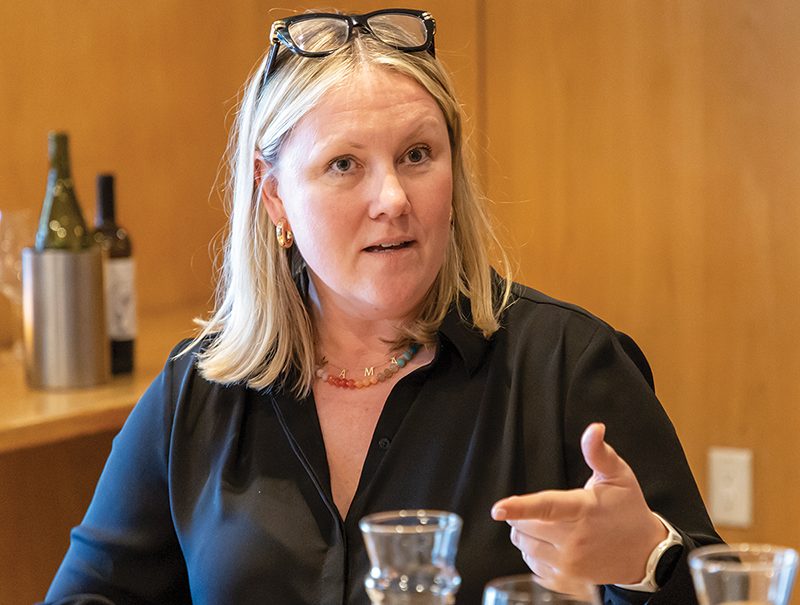
Davidson: Microsoft runs on trust internally. We all use Copilot. We all share our prompts and stories with the team. And it’s not something that’s necessarily a mandate, but it’s something that people are embracing. We also find that, when our employees or subject matter experts share on social media, there’s 15 times more engagement. We also have a very high achieving culture. We hear a lot about generative AI in different forms, but there’s still so much that people don’t know or trust about it. So how we can help people to learn is a big part of the culture within. And then that transpires externally.
Martins: People like following people, not brands. And so how do you leverage your employee base to be those spokespeople? How do you make everybody famous so that they can talk about the brand and get more visibility. You see this movement in the startup world, where they’re building their social channels around the founder, as opposed to the actual business. And they’re talking about what’s working, what’s not, or what features they’re developing.
Carcasole: Creating excitement within the organization, and building a culture of constant knowledge and upskilling – that’s what’s going to help drive your B2B brand.
MacDonald: The personal advocacy of employees is incredibly smart, and it’s the next step of the referral, which is a demonstration of brand experience. And one of the most important things in B2B marketing is the ability to have confidence in the product and to provide a positive brand recommendation. Because, if employees don’t believe it and cannot advocate for it, how in the world can you trust a client to make the investment?
Retelsdorf: To add to that, I like how Shopify’s vision is to basically make the life of becoming an entrepreneur easier. There are so many things that are a pain – Shopify’s job is to remove that. I love the clarity on that from a brand perspective. They said, “You shall use AI because it makes our products better and it helps our customers be better.” It was like the ultimate form of eat-your-own-dog-food, and that will drive the business forward.
Part 2 of this roundtable discussion will be published in our daily newsletter on Thursday.

